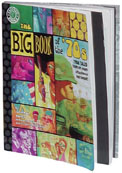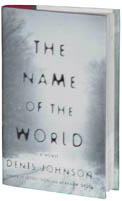|
In Fierce Invalids Home from Hot Climates, Tom Robbins' free-spirited characters shake the foundations of several father-myths that comprise our culture. Robbins' seventh novel atones for his previous stinker, Half Asleep in Frog Pajamas (told in tedious second-person), with a more conventional narrative. The subversive protagonist, CIA Agent Switters, is as kooky and intellectually stimulating as Sissy Hankshaw in Even Cowgirls Get the Blues and Bernard Mickey Wrangle in Still Life with Woodpecker, while serving as the life-loving mouthpiece for Robbins' own quirky wit. After an assignment, Agent Switters flies to Peru to free his grandmother's pet parrot. However, he is sidetracked by Today is Tomorrow, a pagan with a pyramid-shaped head, who gives him a hallucinogen that depicts a method for the conscious transcendence of humanity. Switters' mind-bending experience is the impetus for his subsequent quest, via wheelchair, to help an order of disenfranchized nuns who possess the only draft of Fatima's third prophecy for religion and mankind. During sojourns in Seattle, Syria, and Vatican City, Switters falls for both his sixteen-year-old stepsister and a deflowered/revirginized nun. He also befriends the model for Matisse's Blue Nude 1943, and ultimately, the multiple layers culminate like the third act of a Seinfeld episode. Like his former novels, Robbins challenges us by analyzing established institutions and current events, then he pours them through his semiotic strainer to reveal hidden subtexts. He heightens our awareness with the implications of quantum physics, the electronic age, high- and low-brow art, Catholicism, and cultural commercialization, and meanwhile, he playfully entwines the word for vagina in seventy-one languages. -Clint Stivers
Okay, here's what they DIDN'T cover: Planet of the Apes, Outlaw Country/Southern Rock, disaster movies, Anita Bryant vs. "Adam and Steve," FM radio, van culture, EST and other examples of the "human potential movement," macrame, and 8-track tapes I mean, c'mon, what's more 70s than eight-track tapes?!? But, hell, they had only so many pages. For a decade in which "nothing happened," an awful lot actually happened, and The Big Book of the 70s gives us the lowdown on those celebrated, accursed times. Written by Jonathan Vankin (who produced the fab Big Books of Scandal and Bad) and illustrated by, as the blurb truthfully notes, "50 of the world's top comics artists," the 70s is the latest in Paradox Press' popular "Factoid Books" series of non-fiction comics. With the usual bone-dry Big Book irony, Vankin presents The 70s in sections describing fads, celebrities, and events, with a fourth section about the "Entertainment Explosion," reminding us that this was the decade when the business of America became Show Business. You get sex and slang, "streaking" and "partying," Kissinger and Cosell, "Squeaky" and "Tania," Watergate and the Bicentennial, with a wide variety of art, from Langdon Foss' fine-line realism to Sam Henderson's goofy scrawl. Notable entries include Screw mainstay Danny Hellman's take on Studio 54, "Space Food" featuring Steve Weissman's "Richie Rich-on-skag" style, Terry Laban's dark but humorous Nixon piece, and the chapter on the oft-forgotten "meat shortage," with painterly use of zipatone by Bob (Minimum Wage) Fingerman. Equally impressive is David Lloyd's shadowy drybrush on the terrorism chapter, "Hanoi Jane" with Chris Jordan's thick, inky combo of dead-on caricature and funny stuff, and Paul Pope's lubricious brushwork on "Glam Rock." And it wouldn't be a Big Book without the usual superb work of Roger Langridge ("McDonaldland"), Rick Geary (a gorgeous look at gameshow impresario Chuck Barris) and England's finest, Hunt Emerson ("Punk Rock," of course). And, as always, one of the best chapters, this time regarding Hollywood in the 70s, is drawn by Sergio Aragones, the finest natural cartoonist in the biz. If you said, "Who?" to more than three of the above names shame on ya! Comics are a great American artform, and everybody needs to read more of 'em, dammit. Start with The 70s, and soon your mood ring will glow turquoise with mellow vibes, man. -Bill Widener
In his book Jesus' Son, Denis Johnson turned the short story upside down with sentences that breathed fire. In his new novel, The Name of the World, his mastery of the written word continues. Consider: "Anything higher than a stalk of corn was visible for miles. A scraggly tree way off in the distance had the decisiveness of one clear fact." Though his sentences can at times be overwhelming, The Name of the World is subtle in story. Michael Reed is a history professor at a nameless university in the Midwest, floating through life since his wife and daughter were killed in a car crash a few years earlier. His grief has controlled him so long that he can't live without it anymore. His way of life is set. But things happen to him. He gets bold, becomes spontaneous. Flower Cannon, an art student at the university, steals his attention, and his crush leads him through the novel. Reed's life starts happening to him, slowly waking him up. Reed's awakening is the story. But it is also the story of middle-aged men all over the country. At one point, Johnson writes, "I felt surrounded by the practitioners of a sacred mediocrity, an elegant mediocrity cloistering inaccessible tortures. I don't know quite how to put it. People, men, proud of their clichés yet full of helpless poetry." But Michael Reed is not destined for this. He gets up off the ground, dusts himself off, and throws a punch at the world. -Steven Tweddell
|
 FIERCE INVALIDS HOME FROM HOT CLIMATES
FIERCE INVALIDS HOME FROM HOT CLIMATES  THE BIG BOOK OF THE '70S
THE BIG BOOK OF THE '70S  THE NAME OF THE WORLD
THE NAME OF THE WORLD